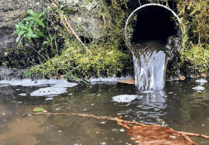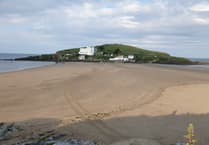In May 2023, South West Water (SWW) published its Drainage and Wastewater Management Plan Yealm-Erme. The wastewater treatment works at Modbury, it said, were “approaching design capacity”.
In other words, there was a limit to the amount of additional effluent the works—first constructed more than 70 years ago—could cope with.
As the Sewage Spills 2024: the 40 Worst Offenders table revealed, during 2022 the Modbury treatment works and the combined sewer overflow at Poundwell Meadow together spilt sewage into Ayleston Brook on 81 occasions, for a cumulative duration of 781.48 hours.
Only a year later, in 2023, the number of spills had increased to 141, collectively lasting a total of 1,522.08 hours.
Although matters improved last year, with spills decreasing to 124 and hours to 1,269.11, both figures remained more than 50 per cent higher than in 2022.
It may therefore be relevant that, since 2022, a further 40 dwellings have been built at Palm Cross—and that an application has now been submitted by Bloor Homes to add another 75.
Rather than risk yet further pollution of the Ayleston Brook— itself a tributary of the River Erme—planning officers should take note of Joint Local Plan Policy DEV35.8, which states:
“Development will not be permitted without confirmation that sewage/wastewater treatment facilities can accommodate or will be improved to accommodate the new development, in advance of the development taking place.”
That requires SWW to explain what steps are being taken to reduce, if not eliminate, the already unacceptably high levels of pollution.
The same requirement also applies to another current application—this time for a residential development of up to 17 dwellings in the village of Harberton.
As readers will know, the wastewater treatment works there discharged sewage into the Harbourne Stream—and eventually into the River Dart—on no fewer than 233 occasions last year.
In total, the spills continued for around 3,603 hours—the equivalent of approximately 25 minutes of every hour, every day, throughout the year.
Even so, that was still a marked improvement in previous years. In 2023 Harberton experienced a total of 327 spills lasting 4,660 hours; in 2022, 260 spills lasting 4,020 hours; and in 2021, 324 spills lasting 4,860 hours.
Last year’s improvement may well be due to the operational upgrades that SWW says have now been completed. Nonetheless, the cause of the “high spill frequency” at the treatment works has been identified as its hydraulic capacity.
In other words, the problem likely has little—if anything—to do with poor maintenance or an underperforming overflow, and more to do with the treatment works itself being incapable of coping with existing demand.
Given the scale of the issue, the draft Harberton Neighbourhood Plan unsurprisingly makes the point:
“Sewage discharges from the Harberton sewage works are a particular concern.”
For now, both applications await determination. But unless officers recommend refusal, both will almost certainly go before the Development Management Committee at Follaton House.
With the South Hams currently unable to demonstrate a five-year housing land supply, more opportunistic applications may yet follow.
It is therefore essential that—regardless of the other material considerations weighing heavily against consent being granted—without confirmation from SWW that there will be no future increase in either the number or duration of sewage spills, the refusal should be automatic.
The purpose of planning is not to permit pollution.





Comments
This article has no comments yet. Be the first to leave a comment.